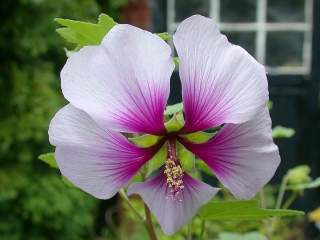 Lavatera maritima Gouan,
Lavatera maritima Gouan, back to Contents and Overview
Photograph Gallery
Lavatera maritima Gouan
Lavatera acerifolia Cavanilles
DNA sequence evidence (ITS) indicates that L. maritima Gouan and L. acerifolia Cavanilles are a pair of closely related species. I judge that this is consistent with morphology, but this hasn't always been reflected in classification; for example Baker includes in De Candolle's section Axolopha L. maritima and some of the Californian Lavateras, whilst Alefeld includes in genus Axolopha L. maritimaand some species from Althaea (section Hirsuta) and Malva (section Bibracteolatae). DNA sequence evidence places the Californian Lavateras deep within a clade consisting of Lavatera section Anthema and Malva section Malva, which is the sister group to Ll. maritima and acerifolia.
They were transferred to Malva in 1998 by M.F. Ray, on the basis of flower and fruit axis characteristics, and RNA sequences, as Malva wigandii (Alefeld) M.F. Ray, and Malva canariensis M.F. Ray respectively.
I continue to present these species under Lavatera as it is under this name that they are still generally known, especially in the horticultural literature.
For convenience I include these 2 species in De Candolle's section Axolopha. However, in the absence of knowledge of the bounds set by De Candolle for this section, I cannot be certain that this is consistent with the rules of botanical nomenclature.
 Lavatera maritima Gouan,
Lavatera maritima Gouan,
![]() Malve
Malve
![]() Lavatère maritime
Lavatère maritime
![]() Malvone delle rupi
Malvone delle rupi
![]() Struikmalva
Struikmalva
![]() malva roquera
malva roquera
![]() Malva de roca
Malva de roca
![]() Maivòni
Maivòni
Distribution: L. maritima Goaun is a soft spreading shrub, native to the West Mediterranean from Corsica, Sardinia and Tunisia to Spain and Morocco. It grows in dry rocky places, usually near the sea.
Description: L. maritima grows to 6 ft. The flowers are 3-6 cm across, opening very flat, and are borne in February-June (later in cooler climates), solitarily or in pairs in the leaf axils. They are usually a pale silver pink with a purple eye. The foliage has a white down consisting of stellate hairs. The leaves are suborbicular, 7cm long and 8 cm wide, with 5 shallow lobes. The fruit is a schizocarp composed of from 9-13 mericarps. The mericarps are strongly ridged, with concave dorsal faces, and sharp, denticulate, angles between the dorsal and lateral faces.
Cultivars: A plant known variously as L. maritima hort, L. bicolor hort, L. maritima 'Bicolor' and L. 'Bicolor' is a larger flowered cultivated form, of uncertain status.
Detailed description with photo-illustrations.
Other cultivars are 'Alba' and 'Princesse de Lignes'.
Synonyms: Synonyms for L. maritima are Althaea maritima (Gouan) Kuntze, Axolopha maritima (Gouan) Alefeld, Axolopha wigandii Alefeld, L. africana Cavanilles, L. bicolor (Rouy) Stapf, L. gallica Hort. Par. ex Nym., L. hispanica Miller, L. maritima subsp bicolor Rouy, L. maritima var floccosa Sennen, L. maritima var incana Sennen, L. maritima f rotundifolia Pau, L. maritima subsp rupestris (Pomel) W. Greuter and Burdet, L. micans (Gouan) Sampaio, L. rotundifolia Lambert, L. rupestris Pomel, L. triloba Gouan, Malva bicolor hort., Malva wigandii (Alefeld) M.F. Ray and Olbia canescens Moench.
Photographs
photograph at Universitat de les Illes Balears
photograph at Webshots
photograph at Country Air Gardens
photograph at Fa. C. Esveld
photographs at Hortiplex
photograph at GardenWeek
photograph at Samplant
photograph
photograph at Arboles Ornamentales
photograph at Kraeuterei
photograph of 'Bicolor' at Desert Tropicals
photograph of 'Princesse de Lignes' at Pepiniere Filippi
Lavatera acerifolia Cavanilles
![]() Canary Tree Mallow,
Canary Tree Mallow,
![]() malva de risco
malva de risco
Distribution: L. acerifolia Cavanilles is a shrub, endemic to the Canary Islands, where it is found as part of the understorey of the thermophilous forest ecosystem. The populations found in Fuerteventura and Lanzarote are assigned to var hariensis.
Description: L. acerifolia is a larger plant than L. maritima growing to 2.5m in height. It can be readily distinguished from the latter by its glabrous nature, the latter being tomentose in most parts. L. acerifolia has glabrous, palmately lobed, irregularly toothed, leaves, borne on 4-9cm petioles. (These leaves are more sharpely lobed than those of L. maritima.) Its flowers are 5-10cm across. They occur singularly or in small terminal or axiliary clusters, and are borne in winter and spring (and sometimes later). The petals are mauve with darker bases, or very occasionally white, and are reflexed.
Propagation: Normally by seed; cuttings require a free draining compost.
Synonyms: Synonyms for L. acerifolia are Althaea acerifolia (Cavanilles) Kuntze, L. phoenicea Willd., Malva acerifolia (Cavanilles) Alefeld, Malva canariensis M.F. Ray and Saviniona acerifolia (Cavanilles) P. Webb & Berthelot.
Photographs
photograph at University of Graz
photographs at Tenerife Information
photograph at Tenerife Information
photograph at University of Basle
photograph at Gobierno de Canarias
photograph at Tacoronte.org
photograph at Arboles Ornamentales
photograph at Olav Thu's Home Page
photograph at Victor M. Olsen's Home Page
References
back to Contents and Overview
Acknowledgements
text, photographs and HTML © 2002, 2003 Stewart Robert Hinsley